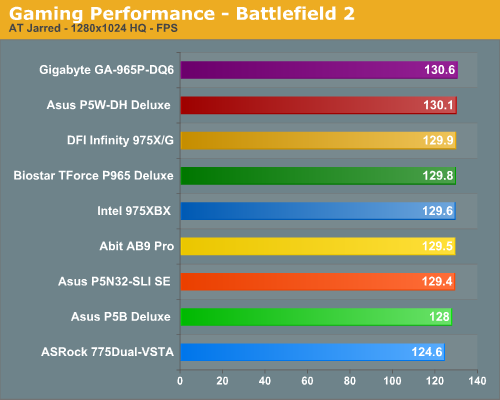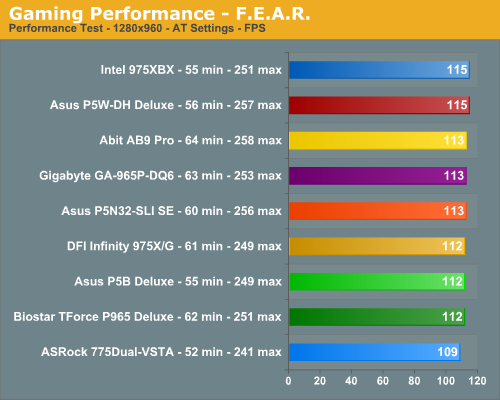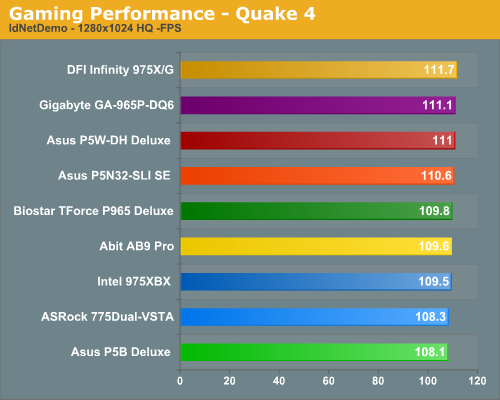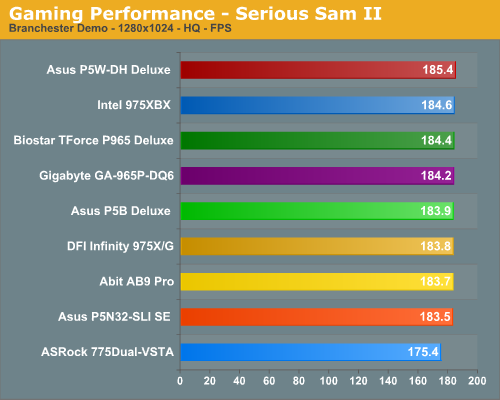Abit AB9-Pro: Mainstream P965 Performance and Pricing
by Gary Key on July 24, 2006 4:45 AM EST- Posted in
- Motherboards
Standard Gaming Performance
As usual, gaming performance was tested with a variety of current games. We ran benchmarks with our standard 1280x1024 resolution without antialiasing enabled (and generally without anisotropic filtering, though that varies by game). Given the number of users that run 19 inch LCDs these days, 1280x1024 represents one of the most commonly used resolutions. We could certainly increase the amount of eye candy being displayed in most of the games, but as this is a motherboard benchmark we aren't particularly interested in maxing out the graphics cards for all tests.





As we commented in our previous Conroe Buyers Guide, gaming benchmarks at these settings are generally very close together, and few people would notice a difference between the various motherboards. With the latest BIOS, the Abit board places pretty consistently right in the middle of all the results. Discounting the ASRock board - which is in a completely different price category and is usually at the bottom of our performance charts - the spread between the fastest and slowest motherboards is only 1%-3%. Basically, your purchase decision should be based on price, features, availability, and manufacturer more than gaming performance.
As usual, gaming performance was tested with a variety of current games. We ran benchmarks with our standard 1280x1024 resolution without antialiasing enabled (and generally without anisotropic filtering, though that varies by game). Given the number of users that run 19 inch LCDs these days, 1280x1024 represents one of the most commonly used resolutions. We could certainly increase the amount of eye candy being displayed in most of the games, but as this is a motherboard benchmark we aren't particularly interested in maxing out the graphics cards for all tests.





As we commented in our previous Conroe Buyers Guide, gaming benchmarks at these settings are generally very close together, and few people would notice a difference between the various motherboards. With the latest BIOS, the Abit board places pretty consistently right in the middle of all the results. Discounting the ASRock board - which is in a completely different price category and is usually at the bottom of our performance charts - the spread between the fastest and slowest motherboards is only 1%-3%. Basically, your purchase decision should be based on price, features, availability, and manufacturer more than gaming performance.










25 Comments
View All Comments
JarredWalton - Monday, July 24, 2006 - link
Being able to look at Merom chips and laptops is one thing; being able to purchase them is another. We will do our best to bring you information as soon as possible, but I really don't expect Merom to be substantially faster/better than Conroe, and I really do expect socket 479 desktop motherboards to be more difficult to find.dugbug - Tuesday, July 25, 2006 - link
Looking forward to your first merom laptop review. I expect it to be slower than conroe, Im more interested in how it compares to core duo/yonah.thanks
-d
bob661 - Monday, July 24, 2006 - link
I figured I would see more comments on this. Odd.exitous - Monday, July 24, 2006 - link
Is there is really any difference between the ab9 pro and the regular ab9 board other than some extra sata ports? The ab9 pro is out of stock now at newegg, so I was thinking of just getting the non pro board instead and saving a few bucks in the process.dasmokedog - Sunday, July 30, 2006 - link
Raid support on the ProGary Key - Monday, July 24, 2006 - link
I cannot comment on this since we do not have a board yet. The obvious differences are in the SATA ports, RAID capabilities, ALC-883 on the AB9, single Gb Ethernet, and couple of other minor differences in board design. How well the ABP overclocks or its stock performance is unknown at this time although I asked Abit to respond to your question. :)EvanAdams - Monday, July 24, 2006 - link
What the hell is PCI-E x1 slots for? What a waste.jonmcguffin - Monday, July 24, 2006 - link
Reminds me of those CNR or AMR (??) Slots we saw a few years ago. I agree, these PCI-E x1 slots are crazy..DigitalFreak - Monday, July 24, 2006 - link
No, their not. Blame the likes of Creative and others for not producing PCI-E cards, not Abit for including the slots. Time marches on, boys.DigitalFreak - Monday, July 24, 2006 - link
their = there. Damn the lack of an edit button!